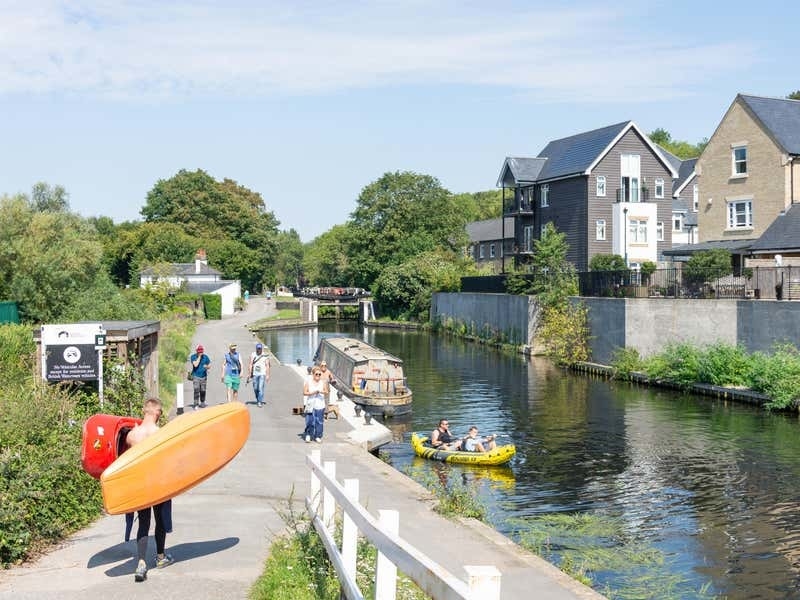Hundreds of chemical pollutants, including toxic “forever chemicals” such as PFAS and PCBs, have been found in the River Colne, an extensive analysis has revealed.
Industrial, agricultural, pharmaceutical and sewage waste – making up at least 267 chemicals – were detected in the river’s water and sediment.
More than half are classed as hazardous to humans, 25 are known or suspected to cause cancer and 17 can be harmful to unborn children or damage fertility, researchers said.
Samples taken between 2019 and 2022 by members of the Colne Valley Fisheries Consultative (CVFC) from nine locations between Watford and the Colne’s source revealed the scale of the pollution that scientists said is typical of many urban rivers.
No river or lake in England has good chemical status while 55% of groundwater bodies are failing.
While the levels were found to be low, Tony Booker of the CVFC is worried about the accumulative effect over time and the possibility of persistent, toxic substances like PFAS and PCBs seeping into aquifers used for drinking water.
He told the PA news agency: “That is the big question. We don’t know the accumulative effect or what the combined effect is.
“It’s like playing the lottery, there might be one chemical that has more of a combined effect than others… these concerns are very much with us at the present time.”
Although there was evidence of raw sewage through chemicals like caffeine, cotinine from tobacco, cholesterol and cocaine, Mr Booker said it was chemicals from other sources that seemed to be wreaking the most ecological havoc.
The @ColneFisheries has published a report: ‘Micropollutants in the River Colne’ revealing detailed analysis of samples of water and sediment taken from the River Colne in #Watford and upstream to the headwatershttps://t.co/IgiWUDpwhe pic.twitter.com/aGfJN5r22v
— ColneCAN (@ColneCAN) April 21, 2023
He said: “Personally, I think there is far too much hype around storm discharges. That isn’t where the problem is.
“In all the years that I’ve been helping to look after River Colne I’ve never seen a fish mortality caused by storm discharge from sewage treatment works.
“But in that same period of time over the years I’ve seen many fish mortalities all caused by issues other than storm discharges.”
Professor Andrew Johnson of the UK Centre for Ecology and Hydrology said “it is the dose that makes the poison” and the presence of toxic chemicals in low quantities is not necessarily harmful.
“There are many thousands of chemicals in rivers, the question is whether they are there in sufficient quantities to harm wildlife,” he said.
“The answer is generally not but some are higher risk than others.
“Persistent organic pollutants can be problematic, such as PFAS, as they may have effects in top predators, particularly if they reach the sea and (are) taken up by long-lived animals like dolphins.”
They are called forever chemicals because they do not break down in the environment and two types, PFOA and PFOS, have been found to cause a range of serious health issues while experts fear there could be hundreds of other toxic varieties.
Guidelines from the Drinking Water Inspectorate (DWI) say water companies should consult with health professionals and monitor PFAS levels in drinking water if they find amounts of 0.01 micrograms per litre (ug/L) and reduce concentrations “as soon as is practicable” if found to be over 0.1 ug/L.
Thames Water said it has five sites with PFAS levels over 0.01 ug/L but none above 0.1 ug/L.
A spokesperson from Affinity Water said: “The vast majority of the water sources that we use have untraceable concentrations of less than 50 ng/l (0.5 ug/L).
“We continually monitor all of our source waters on a risk-based frequency and drinking water is supplied to customers well within the standards set by the DWI.”
Hello Elizabeth, We conduct routine testing for PFAS chemicals in line with regulatory guidance from the Drinking Water Inspectorate (DWI). (1/4)
— Thames Water ? (@thameswater) March 21, 2023
The River Colne investigation found PFAS levels of more than 1.6 ug/kg in the sediment, which Professor Oliver Jones of the RMIT University in Melbourne said was difficult to compare to drinking water guidelines because people do not eat river sediment.
Dr Veronica Edmonds-Brown, an aquatic ecologist at the University of Hertfordshire, said nature is becoming “saturated” with forever chemicals but a lack of research is preventing us from understanding their effect on ecosystems.
She said: “We have little idea of what is in the sediments and few of these chemicals and toxins have had ecotoxicological studies done on aquatic life (macrophytes, algae, fish, invertebrates etc).
“From the 1950s our rivers were pretty dead but then, with monitoring and targets being set, began gradually improving. Through the 1980s and ’90s improvements continued.
“Into the 2000s this started to plateau and we are currently seeing a decline in both biological and chemical status of most of our rivers.
“The natural environment is moving towards saturation level in what it can process – and forever chemicals are just that. No one has looked – so we are very behind on ecological impact studies.”






